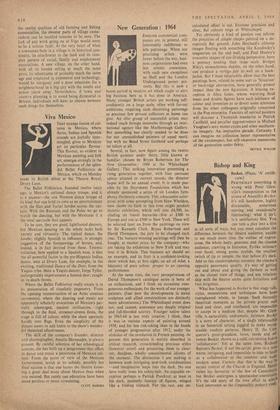Viva Mexico
THAT strange fusion of cul- tures in Mexico, where Aztec, Indian and Spanish strands are joyfully inter- mingled, gives to Mexican art its particular flavour. This flavour, so evident in Mexican painting and folk art, emerges strongly in the performances of the splen- did Ballet Folklorico de Mexico, which on Monday
made its British debut at the Theatre Royal, Drury Lane.
The Ballet Folklorico, founded twelve years ago, is Mexico's national dance troupe, and it is a stunner—the one Western dance troupe of its kind that can hold its own as an entertainment with the Slav and Tartar hordes across the cur- tain. With the Russians and the Poles we go to watch the dancing, but with the Mexicans it is the total spectacle that appeals.
To be sure, they are good, lightfooted dancers,
but Mexican dancing on the whole lacks both variety and virtuosity. The typical dance, the Jarabe, slightly Spanish in influence, is strongly suggestive of the footpawings of horses, and, indeed, is in fact derived from these. Totemic imitation, here applied to a Spanish base, is also the all-powerful factor in the pre-Hispanic Indian dance, seen at Drury Lane, for example, in the exciting, traditional Dance of the Deer, from the Yaquis tribe. Here a Yaquis dancer, Jorge Tyller, unforgettably impersonates a hunted deer, caught in its death throes.
Where the Ballet Folklorico really excels is in
it presentation of ritualistic pageantry. From the opening reconstruction of an Aztec creation ceremonial, where the dancing and music are apparently scholarly evocations of Mexico's par- tially submerged, ancient civilisation, right through to the final, streamer-strewn fiesta, the stage is full of colour, while the sheer spectacle hardly ever flags. Even the simplicity of the
dances seems to add lustre to the show's wonder- ful theatrical effectiveness.
The skill of the company's founder, director and choreographer, Amalia Hernandez, is always present. By careful selection of her ethnological sources, she has built up a programme that offers in dance and music a panorama of Mexican cul- ture. From the point of view of the Mexican Government, lavish in its subsidy, possibly her final success is that one leaves the theatre know- ing a great deal more about Mexico than when one entered. But rarely can education have been more painless or more stimulating.
CLIVE BARNES


































 Previous page
Previous page